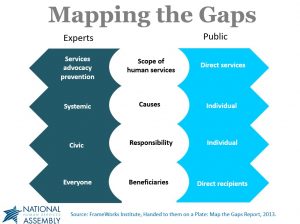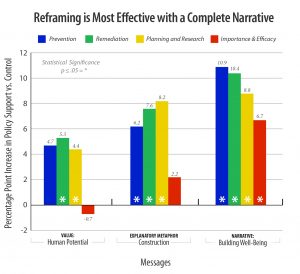Building a Convincing Case for Reframing
April 19, 2018In order to round out our orientation on how to practically apply the Building Well-Being Narrative to your organization and its communications, in this newsletter issue we’ll cover strategies for Building Organizational and Stakeholder Support among leadership (e.g., CEO and Board) and partners. For newsletters on the other introductory topics, see Getting Started, Taking Practical Steps to Sustainable Implementation, Leveraging Coalitions’ Influence, and Reframing in the Real World.
Develop a Pitch
So that you secure an organization-wide commitment to implementing the Building Well-Being Narrative, we recommend crafting a clear, concise ten-minute pitch to convince leadership and stakeholders of reframing’s significance. We’ve found that emphasizing the below needs, solutions, and benefits yields positive feedback and results.
- Needs: With decreasing public funding, and in many cases private donations, as well as the increased push for punitive policies that do not serve the realities of the people who access services and why they do, it is more important than ever to gain public support for your organization by clearly demonstrating the impact human services have improving community well-being by fulfilling human potential. Be sure to highlight any particular funding (e.g. state budget cuts) or policy developments (e.g. onerous eligibility requirements for services) that are impacting your organization and the people you serve.
- Research: The FrameWorks Institute research reveals that the public’s common misperceptions about human services, based on ingrained default cultural narratives, limit support for the sector. For instance, focus groups and surveys showed how public views diverge from experts about causes and responsibility for solutions to people’s challenges. In particular, the public focuses on individual attributes, like willpower and grit, as determinants for well-being, while leaders in the field point to policies, systems, and community conditions. If we want to engage the public more deeply as advocates and supporters, we need to bridge these gaps in understanding.

- Solution: The FrameWorks Institute research shows that presenting human services as a story arc that relies on the Building Well-Being Narrative (human potential value, construction explanatory metaphor, and full lifecycle that includes prevention) is successful in gaining public understanding about human services’ impact.

Source: FrameWorks Institute

Source: FrameWorks Institute, Talking Human Services MessageMemo, 2015.
Benefits: Research shows reframing with the complete narrative is effective in giving the public a more accurate understanding of what human services are (e.g., prevention, research, advocacy) and increases public support for the full range of human services.
- Next Steps: Be prepared to offer ideas for how the organization can start to incorporate reframing in its primary communications, including in a mission statement, or new initiatives, such as upcoming advocacy campaigns (see Getting Started with the Building Well-Being Narrative). Offer suggestions for pacing and prioritizing implementation based on your organization’s staff and resource capacity. For example, you may suggest starting sequentially with the most-used communications pieces that have the biggest impact, such as “about us” language.
Leverage Reframing Resources
In formulating your pitch, make sure to take advantage of the National Reframing Initiative’s resources (including the graphics above) to demonstrate the need for and benefits of reframing:
- Building a New Narrative on Human Services Toolkit includes talking points, tips to increase comfort level with communicating within the new frame, FAQs, and background information on the research informing the reframing recommendations.
- Preframed/Reframed Examples, such as “About Us” statements, program descriptions, and mission statements.
- The FrameWorks Institute Message Memo describing public misperceptions and how to counter them with reframing.
- National Reframing Initiative One-Pager providing an overview of the basics about the initiative.
We’ve received overwhelmingly positive feedback from implementing partners about the advantages of the Building Well-Being Narrative using elements of the above pitch.
Provide Us Feedback
We’re here to help and want to hear from you! To enable us to collect best practices to share across the sector, please send any of your organization’s successes (i.e., what worked, challenges overcome) gaining support for the Building Well-Being Narrative to Bridget Gavaghan, Director of the National Reframing Initiative. Please also email any questions about our pointers to present reframing to your organization’s leadership and stakeholders to Bridget.

